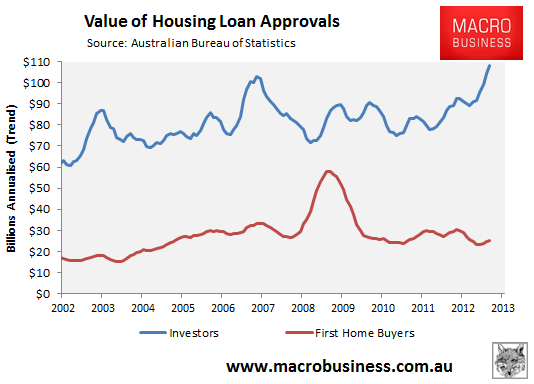
It seems to be the same story throughout the developed world: investors punished by low interest rates and negative returns after-tax are piling money into housing and, in the process, are crowding-out first home buyers (FHBs).
The situation has been well documented in Australia, and is perhaps best summed-up by the next chart showing investor mortgages booming at the same time as FHB mortgage demand remains in the gutter:

In Australia, the surge in investment purchases is being driven by a combination of mums and dads taking advantage of negative gearing tax benefits, self-managed super funds, and foreign buyers, whereas the the drivers are different in other countries.
Take the US, for example, where all-cash purchases have reportedly risen to nearly half of all property sales, with purchases by institutions such as hedge funds rising to 14% of total sales. And while the mechanism is different, the result is the same, with FHBs increasingly being crowded-out. From Bloomberg:
Institutional purchases accounted for 14 percent of sales, according to a report today from RealtyTrac. That was the highest share since the real estate data firm began in 2011 to track transactions by that group, which it defines as buyers of 10 or more homes a year. All-cash sales rose to 49 percent from 40 percent in August and 30 percent a year earlier…
“Both investors and traditional buyers are trying to snap up cheap homes before prices go higher, but the investors have the advantage of paying cash and not having to go through a convoluted mortgage process,” said Michael Hanson, a former Federal Reserve economist now working for Bank of America Corp. in New York. “People are being bid out of some markets because of investor demand”…
The homeownership rate declined to 65 percent in the first half of this year from a peak of 69.2 percent in June 2004. The level is expected to stabilize at about 63 percent, adding more than 2 million households to the rental population…
“The pendulum is swinging too far from the direction we saw during the run-up to the mortgage crisis,” Blomquist said in an interview. “Then, we tried to make everyone an owner. Now, we have people who have the income to pay a mortgage and have the desire to own a home who are stuck being renters”…
In my view, the most effective way to keep homes affordable for FHBs is to ensure that there is an adequate supply of low cost land, as well as minimal planning restrictions on new home building (in both in fringe and inner areas). This way, FHBs will still have adequate options available, even in the face of strong investor demand. There is also likely to be less speculative purchases from investors, as the likelihood of rapid price appreciation will be lower in markets where supply is able to freely adjust to demand.

